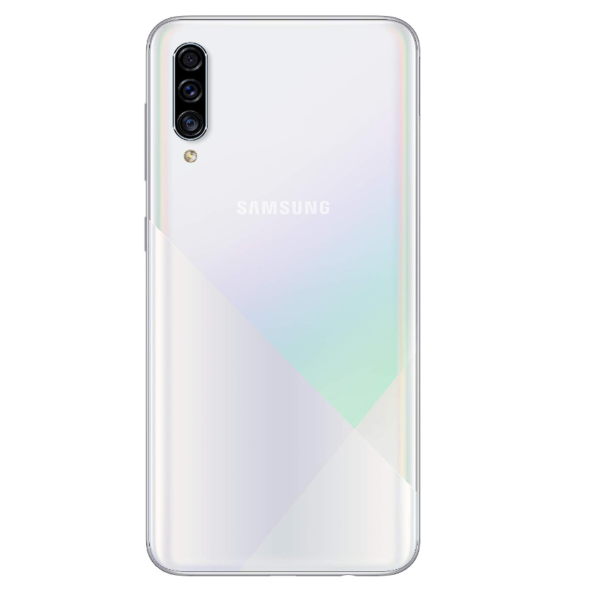- Naxon Tech
- All Products
- Samsung
- Samsung Galaxy A30s Price in India, Specs & More
Samsung Galaxy A30s Price in India, Specs & More



- CPU: Exynos 7904 (14 nm)
- RAM: 3GB | 4GB
- Storage: 32GB | 64GB | 128GB
- Display: 6.4 inches Super AMOLED HD+
- Camera: 25MP + 8MP + 5MP
- OS: Android 9.0 (Pie), upgradable to Android 11, One UI 3.1
Offers
-
 Samsung Galaxy A30s (Prism Crush White, 4GB RAM, 64GB Storage)
₹16,999
Samsung Galaxy A30s (Prism Crush White, 4GB RAM, 64GB Storage)
₹16,999
View Offer
Specs
Network
| Network Technology | GSM / HSPA / LTE |
| 2G Bands |
GSM 850 / 900 / 1800 / 1900 - SIM 1 & SIM 2 (dual-SIM model only) |
| 3G Bands |
HSDPA 850 / 900 / 1700(AWS) / 1900 / 2100 |
| 4G Bands |
1, 2, 3, 4, 5, 7, 8, 12, 13, 17, 20, 28, 38, 40, 41, 66 |
| Speed |
HSPA, LTE-A |
Launch
| Announced |
2019, August 22 |
| Status |
Available. Released 2019, September 11 |
Body
| Dimensions |
158.5 x 74.7 x 7.8 mm (6.24 x 2.94 x 0.31 in) |
| Weight |
169 g (5.96 oz) |
| Build |
Glass front, plastic back, plastic frame |
| SIM <strong>SIM</strong> (Subscriber Identity Module) is a small card that contains mobile network subscriber's account information. This allows the phone using the card to attach to a mobile network. The SIM card is most commonly associated with GSM and UMTS mobile networks. Moving a SIM card from one phone to another allows a subscriber to switch mobile phones without having to contact their mobile network carrier. SIM cards can also be used by a phone to store limited amounts of data, such as phone numbers and text messages. |
Single SIM (Nano-SIM) or Dual SIM (Nano-SIM, dual stand-by) |
Display
| Type <strong>Design Type</strong> called form factor refers to a mobile phone's size, shape, and style as well as the layout and position of major components of phone. There are three major form factors seen in mobile phones => bar phones, folding phones and sliding phones. |
Super AMOLED |
| Size |
6.4 inches, 100.5 cm2 (~84.9% screen-to-body ratio) |
| Resolution |
720 x 1560 pixels, 19.5:9 ratio (~268 ppi density) |
Platform
| OS |
Android 9.0 (Pie), upgradable to Android 11, One UI 3.1 |
| Chipset <strong>Chipset</strong> is a group of integrated circuits designed to perform one or a more dedicated functions, often with real time computing constraints, Popular smartphones are equipped with more advanced embedded chipsets that can do many different tasks depending on their programming. |
Exynos 7904 (14 nm) |
| CPU <strong>CPU</strong> (Central Processing Unit) mostly known as processors, CPU processes instructions in order to carry out certain functions that make your device operate properly. Processors are often described as the brain of computers, smartphones and tablets, Smartphones and tablets rely on processors to carry out their every task, Processors are an incredibly important factor in selecting any type of computing device, including your smartphone. |
Octa-core (2x1.8 GHz Cortex-A73 & 6x1.6 GHz Cortex-A53) |
| GPU <strong>GPU</strong> (Graphics Processing Unit) is a single-chip processor designed to rapidly manipulate and alter memory to accelerate the creation of images in a frame buffer intended for output to a display, This includes things such as lighting effects, object transformations, and 3D motion. |
Mali-G71 MP2 |
Memory
| Card Slot <strong>Memory Card Slot</strong> is a special slot for inserting a memory card. Memory cards allow you to expand the phone's built-in memory, A memory card (sometimes called a flash memory card or a storage card) is a small storage medium used to store data such as text, pictures, audio, and video, for use on small, portable or remote computing devices such as mobile phones, mp3 players, digital cameras. |
microSDXC (dedicated slot) |
| Internal Storage <strong>Internal Storage</strong> is a data storage space (flash memory) mostly used in smartphones, tablets and other electronic devices where operating system, apps, music, photos, videos, files and other user data Is stored. |
32GB 3GB RAM, 64GB 4GB RAM, 128GB 4GB RAM eMMC 5.1 |
Main Camera
| Rear camera |
25 MP, f/1.7, 27mm (wide), PDAF 8 MP, f/2.2, 13mm (ultrawide), 1/4.0", 1.12µm 5 MP, f/2.2, (depth) |
| Features |
LED flash, panorama, HDR |
| Video |
1080p@30fps |
Selfie Camera
| Front camera |
16 MP, f/2.0, 26mm (wide), 1/3.06", 1.0µm |
| Video |
1080p@30fps |
Sound
| Loudspeaker | Yes |
| audio jack | Yes |
Connection
| WLAN |
Wi-Fi 802.11 a/b/g/n/ac, dual-band, Wi-Fi Direct |
| Bluetooth <strong>Bluetooth</strong> is a wireless communications technology for exchanging data between mobile phones, headsets, computers and other network devices over short distances without wires, Bluetooth technology was primarily designed to support simple wireless networking of personal consumer devices. |
5.0, A2DP, LE |
| Positioning |
GPS, GLONASS, GALILEO, BDS |
| NFC <strong>NFC</strong> (Near field communication) is a set of standards for smartphones and similar devices to establish peer-to-peer radio communications with each other by touching them together or bringing them into proximity, usually no more than a few inches. |
Yes (market/region dependent) |
| FM Radio | Yes |
| USB |
USB Type-C 2.0, OTG |
Extra Features
| Sensors <strong>Sensors</strong> are electronic components that detects and responds to some type of input from the physical environment. The specific input could be light, heat, motion, moisture, pressure and location, The output is generally a signal that is converted to use in computing systems, a location sensor, such as a GPS receiver is able to detect current location of your electronic device. |
Fingerprint (under display, optical), accelerometer, gyro, proximity, compass |
Battery & Charging
| Type <strong>Design Type</strong> called form factor refers to a mobile phone's size, shape, and style as well as the layout and position of major components of phone. There are three major form factors seen in mobile phones => bar phones, folding phones and sliding phones. |
Li-Po 4000 mAh, non-removable |
| charging |
15W wired |
Misc
| Colors |
Prism Crush Black, Prism Crush White, Prism Crush Green, Prism Crush Violet2 |
| models |
SM-A307F, SM-A307FN, SM-A307G, SM-A307GN, SM-A307GT |
| SAR |
0.87 W/kg (head) 0.43 W/kg (body) |
| SAR EU |
1.05 W/kg (head) 1.54 W/kg (body) |
| Price |
₹16,999 |
Tests
| Performance | Antutu: 119524 |
Details
The Samsung Galaxy A30s is a smartphone that was released in September 2019. It features a sleek design with a 6.4-inch Super AMOLED display and a resolution of 720 x 1560 pixels. The phone is powered by the Exynos 7904 chipset, coupled with either 3GB or 4GB of RAM and storage options of 32GB, 64GB, or 128GB, expandable via a microSD card.
In terms of cameras, the Galaxy A30s sports a triple-camera setup on the back, consisting of a 25-megapixel primary camera, an 8-megapixel ultrawide lens, and a 5-megapixel depth sensor. On the front, there is a 16-megapixel selfie camera.
The device runs on Android 9.0 Pie, upgradable to Android 11, with Samsung’s One UI 3.1 on top. It is equipped with a 4000mAh non-removable battery and supports 15W wired charging. The phone also features a fingerprint sensor under the display, along with other sensors like accelerometer, gyro, proximity, and compass.
Connectivity options include Wi-Fi, Bluetooth 5.0, GPS, NFC (market dependent), and FM radio. The Galaxy A30s comes in various color options such as Prism Crush Black, Prism Crush White, Prism Crush Green, and Prism Crush Violet2.
Reviews
FAQ
What is the screen size of the Samsung Galaxy A30s?
The Samsung Galaxy A30s features a 6.4-inch Super AMOLED display, providing vibrant colors and sharp visuals.
Can the storage be expanded on the Galaxy A30s?
Yes, the Galaxy A30s has a dedicated microSD card slot, allowing you to expand the storage capacity beyond the internal storage options of 32GB, 64GB, or 128GB.
Does the Galaxy A30s have a fingerprint sensor?
Yes, the Galaxy A30s includes an under-display fingerprint sensor, enabling convenient and secure unlocking of the device.
What is the battery capacity of the Galaxy A30s?
The Galaxy A30s is equipped with a 4000mAh non-removable battery, providing sufficient power for a full day of regular usage. It supports 15W wired charging.
Which version of Android does the Galaxy A30s run on?
The Galaxy A30s initially launched with Android 9.0 Pie and is upgradable to Android 11. It also features Samsung’s One UI 3.1, offering a user-friendly interface and additional features.












